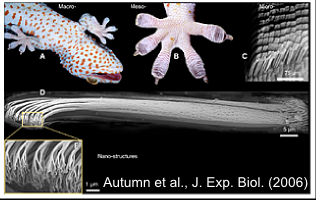 of gecko toes, ranging from meso-scale lamellar (B) to micro-scale seta (D) and nanoscale spatula (E). Utilizing the technique for parallel synthesis of silicon nanowires (left image), we are creating master templates that can be precisely controlled in wire diameter, length, and density. Subsequent molding yields high-aspect-ratio polymer nanofiber arrays (right image) that exhibit high friction with low detachment force. The fibers can be molded with different types of polymers, e.g., polydimethylsiloxane, polypropylene, low- and high-density polyethylene. In addition, schemes are being developed to mimic the additional levels of hierarchy into these nanostructures. Such reversibly attachable adhesives have many potential applications, such as in biomedical and sports equipment, as well as for crawling micro-robots.
of gecko toes, ranging from meso-scale lamellar (B) to micro-scale seta (D) and nanoscale spatula (E). Utilizing the technique for parallel synthesis of silicon nanowires (left image), we are creating master templates that can be precisely controlled in wire diameter, length, and density. Subsequent molding yields high-aspect-ratio polymer nanofiber arrays (right image) that exhibit high friction with low detachment force. The fibers can be molded with different types of polymers, e.g., polydimethylsiloxane, polypropylene, low- and high-density polyethylene. In addition, schemes are being developed to mimic the additional levels of hierarchy into these nanostructures. Such reversibly attachable adhesives have many potential applications, such as in biomedical and sports equipment, as well as for crawling micro-robots. Biomimetics
Nature provides many examples of how micro- and nano-scale structures can lead to interesting macroscopic properties. Self-cleaning lotus leaves, colorful peacock feathers, and the adhesive feet of spiders and geckos are all made possible by the unique surface features that are critical for their survival. Motivated by these biological examples and our experiences in surface modification and characterization, we strive to create materials that have useful engineering applications. Gecko-Inspired Synthetic Adhesives Geckos are known for their remarkable ability to vertically climb and stick to just about any surface. This is enabled by the hierarchical structures on their feet that range from stiff seta and spatula micro- and nano-structures to millimeter-scale lamellar arrays. Mimicking the multi-scale structure of the geckos has remained a challenge in the field. The image at the right displays the hierarchical structures  of gecko toes, ranging from meso-scale lamellar (B) to micro-scale seta (D) and nanoscale spatula (E). Utilizing the technique for parallel synthesis of silicon nanowires (left image), we are creating master templates that can be precisely controlled in wire diameter, length, and density. Subsequent molding yields high-aspect-ratio polymer nanofiber arrays (right image) that exhibit high friction with low detachment force. The fibers can be molded with different types of polymers, e.g., polydimethylsiloxane, polypropylene, low- and high-density polyethylene. In addition, schemes are being developed to mimic the additional levels of hierarchy into these nanostructures. Such reversibly attachable adhesives have many potential applications, such as in biomedical and sports equipment, as well as for crawling micro-robots.
of gecko toes, ranging from meso-scale lamellar (B) to micro-scale seta (D) and nanoscale spatula (E). Utilizing the technique for parallel synthesis of silicon nanowires (left image), we are creating master templates that can be precisely controlled in wire diameter, length, and density. Subsequent molding yields high-aspect-ratio polymer nanofiber arrays (right image) that exhibit high friction with low detachment force. The fibers can be molded with different types of polymers, e.g., polydimethylsiloxane, polypropylene, low- and high-density polyethylene. In addition, schemes are being developed to mimic the additional levels of hierarchy into these nanostructures. Such reversibly attachable adhesives have many potential applications, such as in biomedical and sports equipment, as well as for crawling micro-robots. 
 In addition to fabricating the fiber arrays, we are probing how the fundamental parameters of the nanofibers and the contacting substrate (e.g., fiber and substrate geometry, modulus, and surface energy) affect macroscopic properties like adhesion and friction. This effort provides broader insights for contact between non-ideal surfaces.
In addition to fabricating the fiber arrays, we are probing how the fundamental parameters of the nanofibers and the contacting substrate (e.g., fiber and substrate geometry, modulus, and surface energy) affect macroscopic properties like adhesion and friction. This effort provides broader insights for contact between non-ideal surfaces.
 of gecko toes, ranging from meso-scale lamellar (B) to micro-scale seta (D) and nanoscale spatula (E). Utilizing the technique for parallel synthesis of silicon nanowires (left image), we are creating master templates that can be precisely controlled in wire diameter, length, and density. Subsequent molding yields high-aspect-ratio polymer nanofiber arrays (right image) that exhibit high friction with low detachment force. The fibers can be molded with different types of polymers, e.g., polydimethylsiloxane, polypropylene, low- and high-density polyethylene. In addition, schemes are being developed to mimic the additional levels of hierarchy into these nanostructures. Such reversibly attachable adhesives have many potential applications, such as in biomedical and sports equipment, as well as for crawling micro-robots.
of gecko toes, ranging from meso-scale lamellar (B) to micro-scale seta (D) and nanoscale spatula (E). Utilizing the technique for parallel synthesis of silicon nanowires (left image), we are creating master templates that can be precisely controlled in wire diameter, length, and density. Subsequent molding yields high-aspect-ratio polymer nanofiber arrays (right image) that exhibit high friction with low detachment force. The fibers can be molded with different types of polymers, e.g., polydimethylsiloxane, polypropylene, low- and high-density polyethylene. In addition, schemes are being developed to mimic the additional levels of hierarchy into these nanostructures. Such reversibly attachable adhesives have many potential applications, such as in biomedical and sports equipment, as well as for crawling micro-robots.